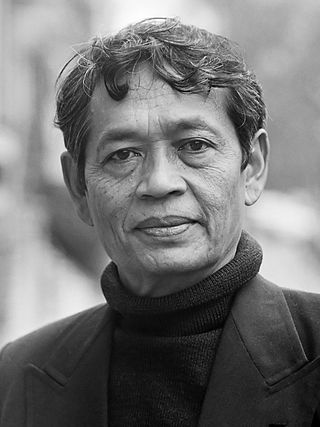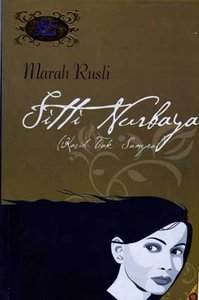
Asia Raya (also spelled Asia-Raja; 'Grand Asia') was a newspaper published in the Dutch East Indies (modern day Indonesia) during the Japanese occupation.

Asia Raya (also spelled Asia-Raja; 'Grand Asia') was a newspaper published in the Dutch East Indies (modern day Indonesia) during the Japanese occupation.
When the Japanese Empire occupied the Dutch East Indies in 1942, they tasked a group of writers and intellectuals to better integrate the native society; this was done in other occupied countries as well. Approximately 190 people of this "Propaganda Division" arrived in Batavia (modern day Jakarta) in early 1942, including novelist Tomoji Abe. Among their efforts was the founding of a newspaper, entitled Asia Raya. [1] This newspaper involved both Japanese and native persons in his management and publication. [2]
The first edition of Asia Raya, totaling four pages in length, was published on 29 April 1942. [2] It was subsequently published daily. The initial print run of 15,000 copies sold at 10 Netherlands Indies cents each. [3] Much of its native editorial staff originated from the Great Indonesia Party (Partai Indonesia Raya, or Parindra) journal Berita Oemoem, a conservative publication. Others originated from more radical, generally leftist, groups. [4] Within a few weeks of its first issue, the newspaper recorded a circulation of 23,000 - a significant amount compared to newspapers published in the Dutch period. [5]
In February 1943, the censorship bureau passed a decree declaring that Asia Raya could no longer publish four pages daily. Owing to a paper shortage caused by the Japanese war effort, the newspaper was limited to two pages daily, with an option for a four-page edition once a week; the board also called for an increase in subscription fees. [3] This took effect in March of that year. In 1944 a surcharge was added to allegedly help pay the salaries of forced labourers and Pembela Tanah Air (PETA) troops. [6]
On 12 March 1945, Asia Raya held a round-table conference at Miyako Hotel in Batavia. Numerous speakers from the New Life Movement (Gerakan Hidoep Baroe), led by Sukarno and Mohammad Hatta, held discourses on ways to invigorate the independence movement. These speakers included future government ministers Oto Iskandar di Nata and Maria Ulfah Santoso, as well as future Prime Minister of Indonesia Sutan Sjahrir. Asia Raya published in-depth transcriptions of the proceedings over a period of three days. [7]
After the Proclamation of Indonesian Independence on 17 August 1945, Asia Raya continued to publish. It focused mainly on details of the new native-run government and the bombings of Hiroshima and Nagasaki. [6] It continued to publish until 7 September 1945, when it ran a large headline reading "Asia Raya Minta Diri" ("Asia Raya Recusing Itself"), ceasing publication due to the change in government. [8]
Today, each edition of Asia Raya has been set on microfilm and is held at the National Archives of Indonesia. [8]
As a propaganda tool, Asia Raya emphasised Japan's visions for a united, prosperous Asia and minimised any coverage of Japanese war crimes. Where coverage could stir up resentment, the paper presented the subject in a positive light; for example, forced labourers going to work outside of Java were described as heroes. [9]
The language used was decidedly pro-Japanese. While Japanese troops were described as "brave" and "powerful", the Allies were described as "wavering", "indecisive", and "weak". [10] These portrayals carried over into the newspaper's advertisements. [11]
Several notable writers contributed poems, short stories, and serials to Asia Raya:

Chairil Anwar was an Indonesian poet and member of the "1945 Generation" of writers. He is estimated to have written 96 works, including 70 individual poems.

Sutan Sjahrir was an Indonesian politician, and revolutionary independence leader, who served as the first Prime Minister of Indonesia, from 1945 until 1947. Previously, he was a key Indonesian nationalist organizer in the 1930s and 1940s. Unlike some of his colleagues, he did not support the Japanese during the Japanese occupation and fought in the resistance against them. He was considered to be an idealist and an intellectual.

Idrus was an Indonesian author best known for his realistic short stories and novels. He is known as the representative of the prose of the '45 generation of Indonesian literature.

Mochtar Lubis was an Indonesian Batak journalist and novelist who co-founded Indonesia Raya and monthly literary magazine "Horison". His novel Senja di Jakarta was the first Indonesian novel to be translated into English. He was a critic of Sukarno and was imprisoned by him.

The Times of Indonesia was a daily English newspaper published in Jakarta, Indonesia. Founded in 1952, it was the first English daily newspaper in Indonesia. The founding editor was Mochtar Lubis, who was also the editor of Indonesia Raya at the time. Mochtar Lubis had close links to the army leadership. In 1953, Lubis stepped down from his position due to the stresses of his simultaneous editorship of Indonesia Raya. Charles Tambu, from Ceylon, took over as managing editor of the newspaper.

Sitti Nurbaya: Kasih Tak Sampai is an Indonesian novel by Marah Rusli. It was published by Balai Pustaka, the state-owned publisher and literary bureau of the Dutch East Indies, in 1922. The author was influenced by the cultures of the west Sumatran Minangkabau and the Dutch colonials, who had controlled Indonesia in various forms since the 17th century. Another influence may have been a negative experience within the author's family; after he had chosen a Sundanese woman to be his wife, Rusli's family brought him back to Padang and forced him to marry a Minangkabau woman chosen for him.

Tengku Amir Hamzah was an Indonesian poet and National Hero of Indonesia. Born into a Malay aristocratic family in the Sultanate of Langkat in North Sumatra, he was educated in both Sumatra and Java. While attending senior high school in Surakarta around 1930, Amir became involved with the nationalist movement and fell in love with a Javanese schoolmate, Ilik Sundari. Even after Amir continued his studies in legal school in Batavia the two remained close, only separating in 1937 when Amir was recalled to Sumatra to marry the sultan's daughter and take on responsibilities of the court. Though unhappy with his marriage, he fulfilled his courtly duties. After Indonesia proclaimed its independence in 1945, he served as the government's representative in Langkat. The following year he was killed in a social revolution led by the PESINDO, and buried in a mass grave.

Poedjangga Baroe was an Indonesian avant-garde literary magazine published from July 1933 to February 1942. It was founded by Armijn Pane, Amir Hamzah, and Sutan Takdir Alisjahbana.

Sanusi Pane was an Indonesian writer, journalist, and historian. He was highly active in literary media, sitting on the editorial boards of several publications. He has also been described as the most important dramatist from before the Indonesian National Revolution.

Atheis is a 1949 Indonesian novel written by Achdiat Karta Mihardja and published by Balai Pustaka. The novel, using three narrative voices, details the rise and fall of Hasan, a young Muslim who is raised to be religious but winds up doubting his faith after dealings with his Marxist–Leninist childhood friend and an anarcho-nihilist writer.

Muhammad Salim Balfas, better known as M. Balfas, was an Indonesian writer and literary critic.

Adnan Kapau Gani, often abbreviated as A. K. Gani, was an Indonesian politician. Born in West Sumatra, he spent much of his youth in Java, where he studied medicine and became involved with the nascent nationalist movement before going to South Sumatra to work as a doctor. During the Indonesian National Revolution he served three terms as Minister of Welfare; two of these were concurrent with terms as a deputy prime minister. Afterwards Gani went to Palembang, South Sumatra, where he remained active in politics until his death. In November 2007 Gani was made a National Hero of Indonesia.

Abisin Abbas, better known by his pseudonym Andjar Asmara, was a dramatist and filmmaker active in the cinema of the Dutch East Indies. Born in Alahan Panjang, West Sumatra, he first worked as a reporter in Batavia. He became a writer for the Padangsche Opera in Padang, where he developed a new, dialogue-centric style, which later spread throughout the region. After returning to Batavia in 1929, he spent over a year as a theatre and film critic. In 1930 he joined the Dardanella touring troupe as a writer. He went to India in an unsuccessful bid to film his stage play Dr Samsi.

Karkono Partokusumo, better known by the pen name Kamadjaja, was an Indonesian journalist and author, who rose to prominence during the Japanese occupation of the Dutch East Indies.

Brig. Gen. Daan Jahja or Daan Yahya was an Indonesian military officer who was the Chief of Staff of the Siliwangi Division in 1948 and the Military Governor of Jakarta from 1949 to 1950.

Oetarjo Anwar Tjokroaminoto was an Indonesian politician and journalist. He served as Minister of Social Affairs for a year in the Wilopo Cabinet, and was the Prime Minister of Pasundan for less than a month during January 1950.

Burhanuddin Mohammad Diah, born only as Burhanuddin, was an Indonesian journalist, diplomat, and businessman, who served as the 18th Indonesian Minister of Information from 1966 until 1968, under the presidencies of Sukarno and Suharto, during the transition to the New Order. He was present at the time of the Proclamation of Independence was being formulated, and was a figure who played an important role in saving the original text of the Proclamation.
Lintong Mulia Sitorus, in pre-1948 spelling Lintong Moelia Sitoroes, was an Indonesian intellectual, writer, translator, lawyer, and Socialist Party of Indonesia politician. He was a key follower of the independent-minded Indonesian nationalist Sutan Sjahrir in the 1940s and 1950s.